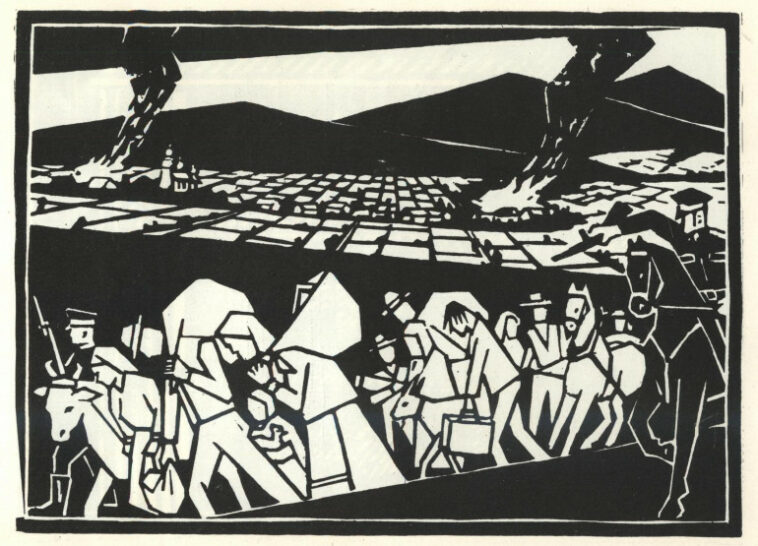As a result of Russia’s bloody war against Ukraine, people suffer the most. Since the large-scale invasion of Ukraine, the occupiers have committed and still commit multiple war crimes, one of which is forced deportation.
As a matter of fact, deportation is not only a phenomenon of modern Russian “war style” but also a long tradition. There are plenty of declassified documents from Soviet security agencies’ archives, which confirm that the forced deportations of separate persons and nations have always been an essential part of Moscow’s repressive and punitive system.
Deportations of Ukrainians as a political tradition of the Soviet Union
When one dives deeper into history, one will find out that some “steps” were taken even before the Soviet Union’s formation. One of them was the decree “on the administrative expelling”, which was passed by the All-Russian Central Executive Committee (10/08/1922) and meant the right of expelling all the suspected persons to remote regions of Russia.
Later, the official “Provision on the Rights of the Unified State Political Administration of the Soviet Union in Terms of Administrative Evictions, Exile, and Imprisonment in Concentration Camps” was passed (28/03/1924) by the Soviet government, which made forced deportation a legal, officially recognized method.
Today, in the XXI century, Russia continues using all the same “rules of war”. There are already about 1 200 000 Ukrainians, deported from the temporarily occupied territories, and many of them are expelled to Siberia, the Far East, and the North Caucasus, as it was decades ago, during the Stalin era.
Through the pages of history: Siberia, Kolyma, Vorkuta
The first mass deportations of Ukrainians during Soviet times are dated to 1929-1930 years when they were one of the elements of “dekulakization” (chain of repressions against wealthy farmers, including arrests, deportations, or executions of wealthy farmers or kulaks aimed to liquidate them as a social class). According to the declassified documents from Soviet security agencies’ archives, about 146 229 persons were expelled from the Ukrainian territory (URSR) in general, about 93 461 persons were sent to the northern regions of the USSR, and about 52 425 persons – to Siberia.
The second “wave” of deportations came with WWII when during September 1939-June 1941 about 1 250 000 people from western parts of Ukraine and Belarus (where many Ukrainians lived) were deported to remote regions of the USSR.
Mariupol today
Mariupol is a living testimony of Russian war crimes. Russian occupiers have deported over 1000 Ukrainian children from the city. According to the Mariupol city council, over 1000 Ukrainian children have been already taken to Russia and are living now in families in far regions of Russia, such as Irkutsk, Tumen, Kemerovo, and Altai Krai. Their parents are being constantly threatened with the loss of parental rights.
Occupiers are aimed to accelerate the process of assimilation and genocide of Ukrainian people as well as to raise a generation loyal to the Kremlin propaganda and incite it with hatred towards Ukraine and Ukrainians. Such actions are a direct violation of the United Nations Convention on the Prevention and Punishment of Genocide (09/12/1948), the Geneva Convention (IV) relative to the Protection of Civilian Persons in Time of War (12/08/1949), and the Convention on Rights of the Child (20/11/1989).
The Donbas Story: Russian Colonization
Special attention must be paid to “the birth” of Donbas in its modern form. In this case, a significant role was played by the “national politics” of the Soviet government and, in particular, by the deportation of people. It is especially important to understand it in the context of the year 2014 and the following events. The population of Donetsk and Luhansk regions was majorly formed by two “waves” of resettlement: from Russian territory (about 3627 families) and the Chernihiv region (over 4000 families). To be more precise, there were three sides of the movement: the West (colonization of Ukraine), the East (colonization of far regions of Russia), and the North (from the earlier settled territories of Slobozhanschchyna).
Summarizing the results of Russian social policy, it is clear that it is still built on the tradition of both the Russian empire and the Soviet Union where the principle “divide et impera” was applied not only to Ukrainian territories but also to people. The ultimate goal of the modern empire is the same old colonialism and erasing the Ukrainian identity to replace it with a “Russian world” quasi-ideology and substitute history with another colonial myth.


